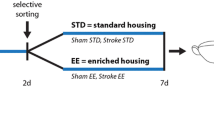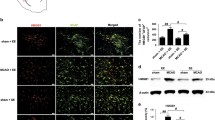Abstract
The three-phase Enriched Environment (EE) paradigm has been shown to promote post-stroke functional improvement, but the neuronal mechanisms are still unclear. In this study, we applied a multimodal neuroimaging protocol combining magnetic resonance imaging (MRI) and positron emission tomography (PET) to examine the effects of post-ischemic EE treatment on structural and functional neuroplasticity in the bilateral sensorimotor cortex. Rats were subjected to permanent middle cerebral artery occlusion. The motor function of the rats was examined using the DigiGait test. MRI was applied to investigate the EE-induced structural modifications of the bilateral sensorimotor cortex. [18F]-fluorodeoxyglucose PET was used to detect glucose metabolism. Blood oxygen level-dependent (BOLD)-functional MRI (fMRI) was used to identify the regional brain activity and functional connectivity (FC). In addition, the expression of neuroplasticity-related signaling pathways including neurotrophic factors (BDNF/CREB), axonal guidance proteins (Robo1/Slit2), and axonal growth-inhibitory proteins (NogoA/NgR) as well as downstream proteins (RhoA/ROCK) in the bilateral sensorimotor cortex were measured by Western blots. Our results showed the three-phase EE improved the walking ability. Structural T2 mapping imaging and diffusion tensor imaging demonstrated that EE benefited structure integrity in the bilateral sensorimotor cortex. PET-MRI fused images showed improved glucose metabolism in the corresponding regions after EE intervention. Specifically, the BOLD-based amplitude of low-frequency fluctuations showed that EE increased spontaneous activity in the bilateral motor cortex and ipsilateral sensory cortex. In addition, FC results showed increased sensorimotor connectivity in the ipsilateral hemisphere and increased interhemispheric motor cortical connectivity and motor cortical-thalamic connectivity following EE intervention. In addition, a strong correlation was found between increased functional connectivity and improved motor performance of limbs. Specifically, EE regulated the expression of neuroplasticity-related signaling, involving BDNF/CREB, Slit2/Robo1, as well as the axonal growth–inhibitory pathways Nogo-A/Nogo receptor and RhoA/ROCK in the bilateral sensorimotor cortex. Our results indicated that the three-phase enriched environment paradigm enhances neuronal plasticity of the bilateral sensorimotor cortex and consequently ameliorates post-stroke gait deficits. These findings might provide some new clues for the development of EE and thus facilitate the clinical translation of EE.








Similar content being viewed by others
References
Hyndman D, Ashburn A, Stack E. Fall events among people with stroke living in the community: Circumstances of falls and characteristics of fallers. Arch Phys Med Rehabil 2002, 83: 165–170.
Langhorne P, Bernhardt J, Kwakkel G. Stroke rehabilitation. Lancet 2011, 377: 1693–1702.
Schmid AA, Van Puymbroeck M, Altenburger PA, Miller KK, Combs SA, Page SJ. Balance is associated with quality of life in chronic stroke. Top Stroke Rehabil 2013, 20: 340–346.
Mao R, Zong N, Hu Y, Chen Y, Xu Y. Neuronal death mechanisms and therapeutic strategy in ischemic stroke. Neurosci Bull 2022, 38: 1229–1247.
Wang H, Arceo R, Chen S, Ding L, Jia J, Yao J. Effectiveness of interventions to improve hand motor function in individuals with moderate to severe stroke: a systematic review protocol. BMJ Open 2019, 9: e032413.
Lee KB, Lim SH, Kim KH, Kim KJ, Kim YR, Chang WN. Six-month functional recovery of stroke patients: a multi-time-point study. Int J Rehabil Res 2015, 38: 173–180.
Johansson B, Ohlsson A. Environment, social interaction, and physical activity as determinants of functional outcome after cerebral infarction in the rat. Exp Neurol 1996, 139: 322–327.
Nygren J, Wieloch T. Enriched environment enhances recovery of motor function after focal ischemia in mice, and downregulates the transcription factor NGFI-A. J Cereb Blood Flow Metab 2005, 25: 1625–1633.
Zhan Y, Li MZ, Yang L, Feng XF, Lei JF, Zhang N, et al. The three-phase enriched environment paradigm promotes neurovascular restorative and prevents learning impairment after ischemic stroke in rats. Neurobiol Dis 2020, 146: 105091.
Annweiler C, Beauchet O, Bartha R, Wells JL, Borrie MJ, Hachinski V, et al. Motor cortex and gait in mild cognitive impairment: A magnetic resonance spectroscopy and volumetric imaging study. Brain 2013, 136: 859–871.
Zingg B, Hintiryan H, Gou L, Song MY, Bay M, Bienkowski MS, et al. Neural networks of the mouse neocortex. Cell 2014, 156: 1096–1111.
Sherman SM. Thalamus plays a central role in ongoing cortical functioning. Nat Neurosci 2016, 19: 533–541.
Takakusaki K. Neurophysiology of gait: From the spinal cord to the frontal lobe. Mov Disord 2013, 28: 1483–1491.
van Meer MPA, Otte WM, van der Marel K, Nijboer CH, Kavelaars A, van der Sprenkel JWB, et al. Extent of bilateral neuronal network reorganization and functional recovery in relation to stroke severity. J Neurosci 2012, 32: 4495–4507.
Lindau NT, Bänninger BJ, Gullo M, Good NA, Bachmann LC, Starkey ML, et al. Rewiring of the corticospinal tract in the adult rat after unilateral stroke and anti-Nogo-a therapy. Brain 2014, 137: 739–756.
Wang H, Xiong X, Zhang K, Wang X, Sun C, Zhu B, et al. Motor network reorganization after motor imagery training in stroke patients with moderate to severe upper limb impairment. CNS Neurosci Ther 2023, 29: 619–632.
Yu K, Wu Y, Zhang Q, Xie H, Liu G, Guo Z, et al. Enriched environment induces angiogenesis and improves neural function outcomes in rat stroke model. J Neurol Sci 2014, 347: 275–280.
Zhang X, Chen XP, Lin JB, Xiong Y, Liao WJ, Wan Q. Effect of enriched environment on angiogenesis and neurological functions in rats with focal cerebral ischemia. Brain Res 2017, 1655: 176–185.
Biernaskie J, Corbett D. Enriched rehabilitative training promotes improved forelimb motor function and enhanced dendritic growth after focal ischemic injury. J Neurosci 2001, 21: 5272–5280.
Autry AE, Monteggia LM. Brain-derived neurotrophic factor and neuropsychiatric disorders. Pharmacol Rev 2012, 64: 238–258.
Alpár A, Tortoriello G, Calvigioni D, Niphakis MJ, Milenkovic I, Bakker J, et al. Endocannabinoids modulate cortical development by configuring Slit2/Robo1 signalling. Nat Commun 2014, 5: 4421.
Mu JD, Ma LX, Zhang Z, Qian X, Zhang QY, Ma LH, et al. The factors affecting neurogenesis after stroke and the role of acupuncture. Front Neurol 2023, 14: 1082625.
Rejdak K, Sienkiewicz-Jarosz H, Bienkowski P, Alvarez A. Modulation of neurotrophic factors in the treatment of dementia, stroke and TBI: Effects of Cerebrolysin. Med Res Rev 2023, 43: 1668–1700.
Nishiyama M, von Schimmelmann MJ, Togashi K, Findley WM, Hong K. Membrane potential shifts caused by diffusible guidance signals direct growth-cone turning. Nat Neurosci 2008, 11: 762–771.
Nagahara AH, Tuszynski MH. Potential therapeutic uses of BDNF in neurological and psychiatric disorders. Nat Rev Drug Discov 2011, 10: 209–219.
Whitford KL, Marillat V, Stein E, Goodman CS, Tessier-Lavigne M, Chédotal A, et al. Regulation of cortical dendrite development by Slit-Robo interactions. Neuron 2002, 33: 47–61.
Andres RH, Horie N, Slikker W, Keren-Gill H, Zhan K, Sun G, et al. Human neural stem cells enhance structural plasticity and axonal transport in the ischaemic brain. Brain 2011, 134: 1777–1789.
Schwab ME. Nogo and axon regeneration. Curr Opin Neurobiol 2004, 14: 118–124.
Schwab ME, Strittmatter SM. Nogo limits neural plasticity and recovery from injury. Curr Opin Neurobiol 2014, 27: 53–60.
Yang L, Li M, Zhan Y, Feng X, Lu Y, Li M, et al. The impact of ischemic stroke on gray and white matter injury correlated with motor and cognitive impairments in permanent MCAO rats: a multimodal MRI-based study. Front Neurol 2022, 13: 834329.
Li M, Zhao Y, Zhan Y, Yang L, Feng X, Lu Y, et al. Enhanced white matter reorganization and activated brain glucose metabolism by enriched environment following ischemic stroke: micro PET/CT and MRI study. Neuropharmacology 2020, 176: 108202.
Nie B, Chen K, Zhao S, Liu J, Gu X, Yao Q, et al. A rat brain MRI template with digital stereotaxic atlas of fine anatomical delineations in paxinos space and its automated application in voxel-wise analysis. Hum Brain Mapp 2013, 34: 1306–1318.
Dolui S, Li Z, Nasrallah IM, Detre JA, Wolk DA. Arterial spin labeling versus 18F-FDG-PET to identify mild cognitive impairment. Neuroimage Clin 2020, 25: 102146.
Liu P, Tu H, Zhang A, Yang C, Liu Z, Lei L, et al. Brain functional alterations in MDD patients with somatic symptoms: A resting-state fMRI study. J Affect Disord 2021, 295: 788–796.
Mandeville ET, Ayata C, Zheng Y, Mandeville JB. Translational MR neuroimaging of stroke and recovery. Transl Stroke Res 2017, 8: 22–32.
Kimura-Ohba S, Yang Y, Thompson J, Kimura T, Salayandia VM, Cosse M, et al. Transient increase of fractional anisotropy in reversible vasogenic edema. J Cereb Blood Flow Metab 2016, 36: 1731–1743.
Fellgiebel A, Wille P, Müller MJ, Winterer G, Scheurich A, Vucurevic G, et al. Ultrastructural hippocampal and white matter alterations in mild cognitive impairment: A diffusion tensor imaging study. Dement Geriatr Cogn Disord 2004, 18: 101–108.
Magistretti PJ, Allaman I. A cellular perspective on brain energy metabolism and functional imaging. Neuron 2015, 86: 883–901.
Joy MT, Carmichael ST. Encouraging an excitable brain state: Mechanisms of brain repair in stroke. Nat Rev Neurosci 2021, 22: 38–53.
Harris JA, Mihalas S, Hirokawa KE, Whitesell JD, Choi H, Bernard A, et al. Hierarchical organization of cortical and thalamic connectivity. Nature 2019, 575: 195–202.
Usrey WM, Sherman SM. Corticofugal circuits: Communication lines from the cortex to the rest of the brain. J Comp Neurol 2019, 527: 640–650.
Tennant KA, Taylor SL, White ER, Brown CE. Optogenetic rewiring of thalamocortical circuits to restore function in the stroke injured brain. Nat Commun 2017, 8: 15879.
Faverjon S, Silveira DC, Fu DD, Cha BH, Akman C, Hu Y, et al. Beneficial effects of enriched environment following status epilepticus in immature rats. Neurology 2002, 59: 1356–1364.
Kondo M, Takei Y, Hirokawa N. Motor protein KIF1A is essential for hippocampal synaptogenesis and learning enhancement in an enriched environment. Neuron 2012, 73: 743–757.
Wang L, Cao M, Pu T, Huang H, Marshall C, Xiao M. Enriched physical environment attenuates spatial and social memory impairments of aged socially isolated mice. Int J Neuropsychopharmacol 2018, 21: 1114–1127.
Marosi K, Mattson MP. BDNF mediates adaptive brain and body responses to energetic challenges. Trends Endocrinol Metab 2014, 25: 89–98.
Acknowledgements
This work was supported by the National Natural Science Foundation of China (82174471).
Author information
Authors and Affiliations
Corresponding author
Ethics declarations
Conflict of interest
The authors declare no competing financial interests.
Supplementary Information
Below is the link to the electronic supplementary material.
Rights and permissions
Springer Nature or its licensor (e.g. a society or other partner) holds exclusive rights to this article under a publishing agreement with the author(s) or other rightsholder(s); author self-archiving of the accepted manuscript version of this article is solely governed by the terms of such publishing agreement and applicable law.
About this article
Cite this article
Lu, Y., Lin, Z., Li, M. et al. Three-phase Enriched Environment Improves Post-stroke Gait Dysfunction via Facilitating Neuronal Plasticity in the Bilateral Sensorimotor Cortex: A Multimodal MRI/PET Analysis in Rats. Neurosci. Bull. (2023). https://doi.org/10.1007/s12264-023-01155-1
Received:
Accepted:
Published:
DOI: https://doi.org/10.1007/s12264-023-01155-1




